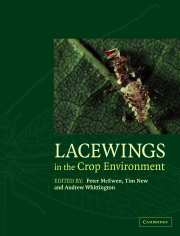Book contents
- Frontmatter
- Contents
- List of contributors
- Preface
- PART 1 Lacewing systematics and ecology
- PART 2 Lacewings in crops
- PART 3 Principles
- PART 4 Case studies
- Introduction to Part 4
- CHAPTER 18 Micromus tasmaniae: a key predator on aphids on field crops on Australasia?
- CHAPTER 19 Preliminary notes on Mallada signatus (Chrysopidae) as a predator in field crops in Australia
- CHAPTER 20 An evaluation of lacewing releases in North America
- CHAPTER 21 Chrysoperla externa and Ceraeochrysa spp.: potential for biological control in the New World tropics and subtropics
- CHAPTER 22 Comparative plant substrate specificity of Iberian Hemerobiidae, Coniopterygidae, and Chrysopidae
- CHAPTER 23 Lacewings in Sardinian olive groves
- CHAPTER 24 Lacewing occurrence in the agricultural landscape of Pianura Padana
- CHAPTER 25 Lacewings and snake-flies in Piedmont vineyards (northwestern Italy)
- CHAPTER 26 Control of aphids by Chrysoperla carnea on strawberry in Italy
- CHAPTER 27 Artificial overwintering chambers for Chrysoperla carnea and their application in pest control
- CHAPTER 28 Lacewings in Andalusian olive orchards
- CHAPTER 29 The green lacewings of Romania, their ecological patterns and occurrence in some agricultural crops
- CHAPTER 30 Biological control with Chrysoperla lucasina against Aphis fabae on artichoke in Brittany (France)
- PART 5 Conclusion
- Taxonomic index
- General index
CHAPTER 28 - Lacewings in Andalusian olive orchards
Published online by Cambridge University Press: 04 May 2010
- Frontmatter
- Contents
- List of contributors
- Preface
- PART 1 Lacewing systematics and ecology
- PART 2 Lacewings in crops
- PART 3 Principles
- PART 4 Case studies
- Introduction to Part 4
- CHAPTER 18 Micromus tasmaniae: a key predator on aphids on field crops on Australasia?
- CHAPTER 19 Preliminary notes on Mallada signatus (Chrysopidae) as a predator in field crops in Australia
- CHAPTER 20 An evaluation of lacewing releases in North America
- CHAPTER 21 Chrysoperla externa and Ceraeochrysa spp.: potential for biological control in the New World tropics and subtropics
- CHAPTER 22 Comparative plant substrate specificity of Iberian Hemerobiidae, Coniopterygidae, and Chrysopidae
- CHAPTER 23 Lacewings in Sardinian olive groves
- CHAPTER 24 Lacewing occurrence in the agricultural landscape of Pianura Padana
- CHAPTER 25 Lacewings and snake-flies in Piedmont vineyards (northwestern Italy)
- CHAPTER 26 Control of aphids by Chrysoperla carnea on strawberry in Italy
- CHAPTER 27 Artificial overwintering chambers for Chrysoperla carnea and their application in pest control
- CHAPTER 28 Lacewings in Andalusian olive orchards
- CHAPTER 29 The green lacewings of Romania, their ecological patterns and occurrence in some agricultural crops
- CHAPTER 30 Biological control with Chrysoperla lucasina against Aphis fabae on artichoke in Brittany (France)
- PART 5 Conclusion
- Taxonomic index
- General index
Summary
INTRODUCTION
Olive cultivation is of great importance in the Mediterranean Basin, representing 97% of world production. Spain, with 27% of world production, is the foremost olive-growing country in the world in terms of surface area under cultivation, and 60% of the national production is concentrated in Andalusia (Porras Piedra et al., 1995; Barranco et al., 1997).
Factors that have a negative impact on this crop include pests, diseases, and weeds, for which losses in yield can reach 30% (De Andrés Cantero, 1991). Among the 18 recognised insect pests, the three most serious are: Bactrocera oleae (Gmelin), the olive fruit fly; Prays oleae (Bernard), the olive moth; and Saissetia oleae (Olivier), the olive scale (Bellido, 1975; Campos, 1976; Briales, 1984; Civantos, 1995). Currently, protection against these pests relies on concepts of integrated control based on knowledge of the environment and of the population dynamics within the agricultural systems and, in this sense, both chemical as well as biological methods are used. The aim is to reduce the insect populations to levels at which the damage caused does not exceed certain economic thresholds (Civantos & Sanchez, 1994; Civantos, 1995).
The utilisation of entomophagous insects plays a key role within the widest concept of integrated olivepest control. Most of the work performed to date on natural enemies in southern Spain has focused on parasitoids (Jimenez et al., 1969; Campos & Ramos, 1981; Briales & Campos, 1985; Montiel Bueno & Santaella, 1995) rather than on the predators (Morris, 1997). However, numerous studies have been conducted on chrysopids, given that lacewing larvae are major oophagous predators of the olive moth (Montiel Bueno, 1981; Ramos et al., 1983a, b).
- Type
- Chapter
- Information
- Lacewings in the Crop Environment , pp. 492 - 497Publisher: Cambridge University PressPrint publication year: 2001
- 7
- Cited by



